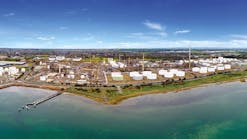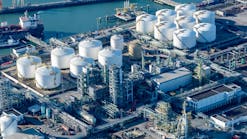FACTS: Earthquake, tsunami take 'massive toll' on Japan's refineries
Eric Watkins
OGJ Oil Diplomacy Editor
LOS ANGELES, Apr. 8 -- Japan’s refining industry has been hard hit by the 9.0-magnitude earthquake and resulting tsunami that struck the country on Mar. 11, according to a report by FACTS Global Energy.
“At one point, as many as six refineries halted operations, suspending approximately 1.4 million b/d of refining capacity, or about a third of Japanese total capacity,” FACTS said.
“This significant shutdown of refining capacity is expected to help to tighten the petroleum product markets in the region as Asian refineries enter the spring maintenance season,” the FACTS report said.
Fortunately, planned shutdowns this year—mostly from China, South Korea, and India—are not as high as in 2009 and 2010.
Nonetheless, FACTS said the crack spreads of products started to show an apparent shift after the quake in Japan. Net diesel exports from Japan averaged 190,000 b/d last year.
The Singapore diesel spread relative to Dubai has strengthened from $19.36/bbl in the Mar. 1-10 period to $22.83/bbl for Mar. 11-16.
“We expect an increase in low-sulfur fuel oil demand for power generation due to outages of nuclear plants,” FACTS said, adding that the crack spreads of low-sulfur waxy residual fuel oil (LSWR) improved from a discount of $7.73/bbl to Dubai crude prior to the quake to $3.68/bbl after the quake.
Change in gasoline crack spreads is limited, according to FACTS, with a rise of only $0.42/bbl over the same period. Japan was a small net exporter of gasoline in 2010 averaging 20,000 b/d.
Naphtha crack spreads, on the other hand, dropped by $1.65/bbl over the same period as several petrochemical crackers have been shut down as a result of the quake. Japan imported 468,000 b/d of naphtha in 2010.
As a result of a significant rise in diesel crack spreads, overall Singapore cracking margins have increased $2.29/bbl since the earthquake (Mar. 1-10 vs. Mar. 11-16). Hydroskimming margins also improved close to $2.90/bbl due to the strengthening of fuel oil crack spreads.
“As a major net exporter of diesel and major net importer of naphtha, Japan has a significant influence on these two products,” FACTS said.
The surge in use of LSWR can also have an impact on the market as Asian supply is tight, the report states. Hence, it is important to have a better understanding on the current status of the affected refineries.
Making up the loss
To make up for the loss in Japanese refining capacity in the aftermath of the disaster, some refiners have planned to increase their crude runs.
Brazil’s Petroleo Brasileiro SA (Petrobras) has reportedly increased production at its 100,000-b/d Nansei Sekiyu Nishihara refinery in Okinawa by 24%. Production at the facility was 46,000 b/d before the earthquake.
JX also has reportedly planned to increase operating rates at its Okayama and Oita refineries by 30,000 b/d.
FACTS said Cosmo Oil has also reportedly planned to increase runs at its three other undamaged refineries in Sakai (100,000 b/d), Sakaide (110,000 b/d), and Yokkaichi (125,000 b/d).
Cosmo Oil is said to be negotiating with the Ministry of Economy, Trade, and Industry (METI) to reverse last year’s decision that decreased the company’s overall nameplate capacity by 12% due to falling oil products demand in Japan.
The Japanese government has lowered the obligation for industries to hold emergency stocks by 3 days to 67 days, according to the International Energy Agency. As a result, around 8 million bbl of products could be released into the market.
“Nonetheless, Japan’s product imports may still rise as a result of the refining outages, and some damaged refineries may take a while to come back on stream,” FACTS said.
Depending on the duration of the shutdown at the affected refineries, it is possible that METI will allow refiners to reverse (at least temporarily) some or all of the 285,000 b/d of refining capacity closures that occurred in 2010.
A further 160,000 b/d was scheduled to permanently be removed from operable capacity this year at Fuji Oil’s Sodegaura and Toa Oil’s Keihin plants, but this could potentially be postponed to aid the country during reconstruction.
“Overall, barring a meltdown of nuclear plants, we should start to see the market easing back to normalcy over the next few weeks, and as a result, we expect cracking margins to moderate,” FACTS said.
Contact Eric Watkins at [email protected].

